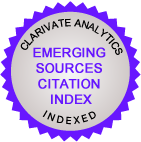Indexing is of paramount importance in publishing, especially when it comes to journals. In an age where the market is flooded with journals competing to publish the highest caliber work and the latest innovative research, indexing is a further mark of credibility, validating the existence of the journal and its objectives.

Web of Science, owned by Clarivate, is one of the most premier and trusted publisher-independent global citation databases. Being the innovative powerhouse that it is, they are consistently looking for ways to improve their methods of inclusion, as well as the usage of material that is already present in their database. One of their most successful innovations was the creation of the Emerging Sources Citation Index (ESCI).
Below we discuss the Emerging Sources Citation Index (ESCI), its benefits, and what authors and editors need to know to take full advantage of the ESCI algorithm. To-date, IGI Global has 62 journals accepted into ESCI. View the full list
here.
What is the Emerging Sources Citation Index (ESCI)?

The Emerging Sources Citation Index, or ESCI, is the first tier of indexing for journals within the Web of Science core collection system, the second tier includes the flagship indices of SCIE, SSCI, and AHCI.
ESCI includes 7,800 of the world’s highest-quality journals across 254 disciplines. More than 3 million records and 74 million cited references date back from 2005 to present. The journals included in ESCI cover all disciplines and range from international and broad scope publications to those that provide deeper regional or specialty area coverage. They are carefully selected by the Web of Science expert in-house editors for editorial rigor and best practice at a journal level.
The purpose of ESCI is to help these high-quality journals gain recognition and usage, which can push the journal through to one of the more specialized indices like the Science Citation Index Expanded (SCIE) and the Social Sciences Citation Index (SSCI) – note that IGI Global currently has five journals indexed in SCIE and two journals indexed in SSCI. These are the flagship indices that include journals representing the top 4% of cited journals within their subject area.
One of the many benefits of being included in ESCI is that the journal gains a tremendous amount of notoriety for its quality. Web of Science evaluates a journal on 24 quality criteria before it can be included in ESCI. Some of those criteria include- but are not limited to- content, timeliness, clarity, code of ethics, and a thorough peer review process. Passing all 24 quality criteria is a good sign of a first-rate academic publication. To learn more about the indexing process, please view IGI Global’s Newsroom post titled, “
Prestigious Indices – What Does It Take to Get Your Journal Accepted?”.
Another benefit of being indexed in ESCI and other known indices is the increased visibility of the articles published within the journal. Other researchers put their trust in the content that is included in ESCI and will be more inclined to use and cite the journals included therein. By increasing the citation rates and usage of these journals, they have a better chance of being accepted into one of the more exclusive flagship indices and later earn an impact factor. They can do so by passing the last 4 criteria on impact. The criteria includes comparative citation analysis, author citation analysis, editorial board citation analysis, and content significance.
It is important to note that every journal included in Web of Science is consistently re-evaluated every year. This means that a journal can move from ESCI to a flagship index upon re-evaluation of its usage and citation rates. However, the journal can also move from a flagship down to ESCI, or even be removed from the database altogether, if it no longer meets the conditions for inclusion upon re-evaluation. Once journals are accepted into ESCI, they will be given an estimated impact factor to determine whether or not they should be accepted into the flagship indices. Roughly only 4% of journals in ESCI will be promoted to the flagship indices. So, the usage and citation rates for the journals remain crucial to their indexing eligibility.
What Editors Can Do to Increase Their Journal’s Chances of Being Indexed
The basic indexing requirements for most indices includes:
- Publication of high-quality content with more research forthcoming
- Timeliness of publication
- Quantitative citation data with low self-citation rates
- Diverse authorship
- Journal has been established for two or more years
Focusing on the health of the journal and making sure that the publication’s quality and all editorial processes are maintained will increase the chances of the journal passing the editorial evaluation for inclusion into ESCI and numerous other indices out there.
To increase the chances of a journal passing the evaluation on impact for inclusion into the flagship indices, there are many things an editor can do to maximize the discoverability of their journal.
- Recommend the journal to their library
- Recommend the journal to their colleagues and students
- Share the journal’s webpage by means of their social and professional networks
- Create/connect their ORCID iD to their IGI Global profile
- Adopt (or recommend for course adoption) the journal or some of its published articles into a course
- Encourage review board members to advocate for the journal
- Encourage contributors to promote and share their published research – sharing opportunities are outlined in IGI Global’s Fair Use Policy
- Network with editors of other related journals for cross-promotional opportunities
- Be aware of award applications and opportunities that the journal could be applicable for
- Seek out potential opportunities for platforms that can provide a review/testimonial for the journal (a publication promotional review)

It is crucial that editors keep a close eye on their review board. Reviewers must be comprised of researchers and academicians who are experts in fields relevant to the journal’s scope. They also play a crucial role in the timely publication of articles, so they should be active and engaged. The Editor(s)-in-Chief of every journal must continuously maintain their review boards by reminding members to update their information and affiliations, removing any problematic members, promoting and adding new members as others leave, and ensuring all members are active and performing quality and timely reviews and that their expertise matches the current scope and objectives of the journal. Indices are doubling down on the review boards of all journals submitted for evaluation, so a disorganized board can destroy a journal’s chances. We recommend taking a look at IGI Global’s Newsroom article titled, “
How the Editorial Review Board Can Make or Break a Journal”.
Review board members are heavily encouraged to support with advocating for the journal. It’s important that reviewers serving a journal understand that as the journal is accepted into prominent indices, it doesn’t just raise the prestige of the journal, but also their role as a reviewer supporting its quality content.
What Authors Can Do to Increase the Sharing Power of Their Research
Authors are a key component in the network of discoverability for their published research. Depending on the type of model an author publishes under, there are a plethora of ways for them to share their work.
If their article was published under standard access under the journal’s subscription-based model, under
IGI Global’s Fair Use Policy, they are able to share their subscription-based (standard access) article by posting the final typeset PDF (which includes the title page, table of contents and other front materials, and the copyright statement) of the article manuscript (NOT THE ENTIRE JOURNAL ISSUE), on their secure personal website and/or their institution’s repository site. The title and abstract of the article (not the full article) may be shared on third-party sites such as ResearchGate, Academia.edu, SSRN, etc.
If an author publishes their work as open access (OA) under Creative Commons licensing, they have full freedom to share and distribute the work however they wish without any limitations. We strongly encourage authors to share out their OA article among the academic community by posting their work through the channels listed below. This will help further support the journal’s citation impact and of course increase the overall impact and reach of the author’s work.
Open access articles (the full text) can be shared:- To institutional repositories.
- On platforms such as ResearchGate, arXiv, Academia.edu, SSRN, and/or society-sponsored sites.
- On the author’s secure personal website.
- Via use in a course pack.
- To a third party to post, copy, distribute, sell, or give for free or for any monetary consideration.
- As a republished manuscript in a future journal or book publication.
It is essential that while the journals are under review, every opportunity is taken to increase the visibility and significance of the quality research they hold.
Conclusion
The indexing process for Web of Science may seem complicated for first time authors or editors, but the basic thing to know is ESCI is a wonderful steppingstone for greater things, and is a sign of good quality, well-researched, and thoroughly reviewed material that deserves to be shared with the academic community. Simply being accepted to the ESCI index is a feat to be proud of, but the work is never over. It’s important to always keep momentum going and continue efforts to increase the discoverability of journals as much as possible. Editors, authors, managing editors, associate editors, and reviewers have a big part to play that can increase a journal’s chances of being indexed into ESCI, and eventually into the flagship indices as well.
To view the full list of indices IGI Global publications are accepted into, please go to our
Journal Indices page and click on the index you are looking for.
About IGI Global
Founded in 1988 and headquartered in Hershey, Pennsylvania, USA with a subsidiary office (IGI Science and Technology, Ltd.), operating out of Beijing, China, IGI Global is a medium-sized, independent academic publisher committed to facilitating the discovery of pioneering research that enhances and expands the body of knowledge available to the global research community. Working in close collaboration with expert researchers and professionals from leading institutions, IGI Global publishes quality content across 350+ topics in 11 core subject areas, including business, computer science, education, engineering, healthcare, social sciences, and more. All these publications have been contributed by over 150,000+ industry-leading researchers and experts worldwide, ensuring that each title contains the most emerging and timeliest research. To learn more about IGI Global, click here.
Newsroom Contact
Emma Baronak
(717) 533-8845 ext. 183
ebaronak@igi-global.com
www.igi-global.com